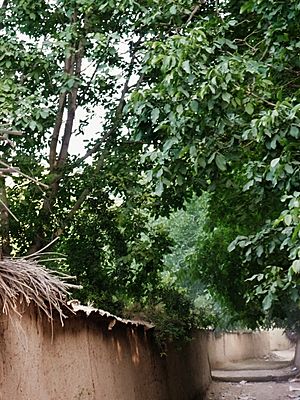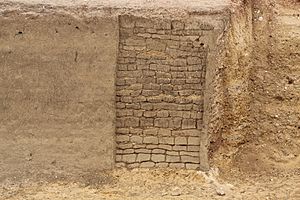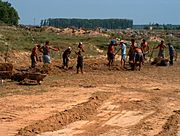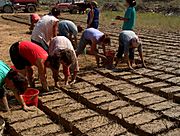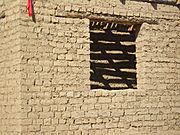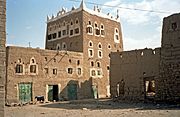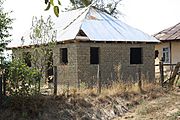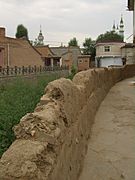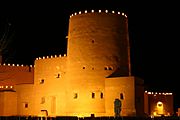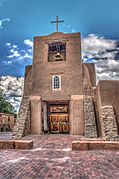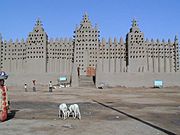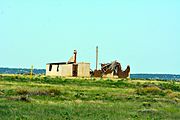Adobe facts for kids
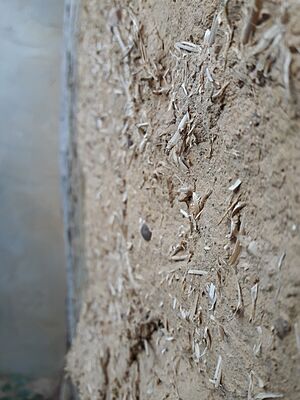
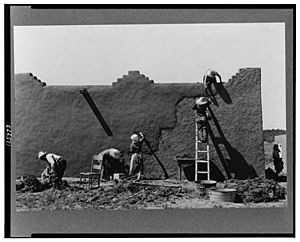
Adobe is a special building material. It's made from earth mixed with natural things like straw. The word "adobe" comes from Spanish and means "mudbrick." People have used adobe for thousands of years all over the world. Buildings made of adobe often look like those made from cob or rammed earth. It's one of the oldest building materials still used today.
Contents
What is Adobe?
Adobe bricks are shaped like rectangles. They are small enough to dry in the air without cracking. Once dry, these bricks are put together using more adobe mud as a glue. This creates strong walls for buildings.
Adobe Brick Sizes
Adobe bricks don't have one standard size. Their size can change a lot depending on where and when they were made. Some common sizes are about 8 by 4 by 12 inches, weighing around 25 pounds. Larger ones can be 10 by 4 by 14 inches, weighing about 35 pounds. Some bricks can even weigh up to 100 pounds! If the mud is too heavy to move as bricks, builders might use a different method called rammed earth.
How Strong is Adobe?
In places with dry weather, adobe buildings can last a very long time. Some of the oldest buildings in the world are made of adobe. Adobe walls are very thick, which helps keep buildings cool in hot weather and warm in cool weather.
Adobe and Earthquakes
However, adobe buildings can be easily damaged by earthquakes if they are not made stronger. For example, many adobe structures were badly damaged in the 1976 Guatemala earthquake, the 2003 Bam earthquake, and the 2010 Chile earthquake. Builders often add special supports to make adobe buildings safer in earthquake zones.
Where is Adobe Used?
Buildings made from sun-dried earth are found all over the world. You can see them in the Middle East, Africa, South America, and parts of North America and Europe.
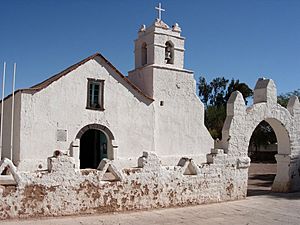
Indigenous peoples of the Americas used adobe for thousands of years. This was common in the Southwestern United States, Mesoamerica, and the Andes mountains. Early Puebloan peoples built with adobe using their hands or baskets. Later, the Spanish taught them how to make bricks. Adobe bricks were also used in Spain as far back as the Late Bronze and Iron Age. Adobe is popular because it's simple to make and affordable.
Adobe vs. Adobines
Sometimes, people talk about "adobes" and "adobines." "Adobes" are smaller bricks, similar to regular baked bricks. "Adobines" are much larger, sometimes one to two yards (about 1 to 2 meters) long!
The History of the Word "Adobe"
The word "adobe" has been around for about 4,000 years. It hasn't changed much in how it sounds or what it means. It comes from an ancient Egyptian word, ɟbt, which meant "mudbrick." This word changed over time through different languages like Coptic and Arabic. Finally, it became adobe in Old Spanish language. English speakers started using the word in the early 1700s.
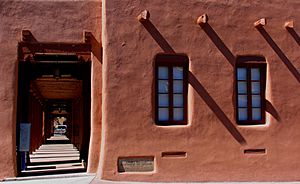
Today, in North America, "adobe" can also mean a style of architecture. This style is popular in desert areas like New Mexico. It describes the look of a building, even if it wasn't built with actual adobe bricks.
What is Adobe Made Of?
An adobe brick is a mix of earth, water, and organic materials. These organic materials can be straw or even animal dung. The best soil for adobe usually has sand, silt, and clay.
Why Add Straw or Dung?
Straw or dung helps the brick hold together. It also helps the brick dry evenly. This stops the brick from cracking as it shrinks.
Ideal Soil Mix
The best soil for adobe mud has about 15% clay, 10–30% silt, and 55–75% fine sand. Another good mix is 15–25% clay, with the rest being sand and larger particles. Modern adobe sometimes has asphalt or Portland cement added. This makes it even stronger.
It's important not to have too much "expansive clay." This type of clay can cause uneven drying and cracking. Too much kaolinite clay can make the brick weak. Luckily, soils in places like the Southwestern United States often have the right mix for adobe.
How Adobe Works as a Building Material
Adobe walls are "load bearing." This means they carry their own weight down to the foundation. So, the adobe itself must be strong enough to support the building.
Keeping Cool and Warm
Adobe is cheap to use and doesn't need many resources. Its thick walls are great at storing heat. In places with hot days and cool nights, adobe walls absorb heat during the day. Then, they slowly release it at night, keeping the inside of the building comfortable. This is called "thermal mass."
Building with Adobe
There are different ways to build with adobe.
Poured and Puddled Walls
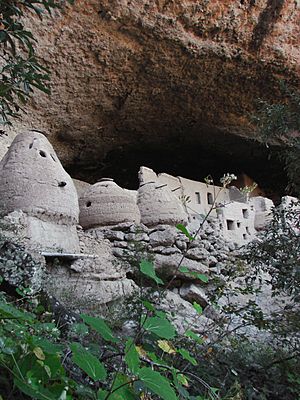
"Poured" or "puddled" adobe is also called cob. This method involves placing soft adobe mud in layers. It's different from making individual bricks. "Puddle" means a clay-based material that is worked until it's thick and moldable. This was the oldest way to build with adobe in the Americas. Later, people started using wooden forms to make individual bricks, a method brought by the Spanish.
Making Adobe Bricks
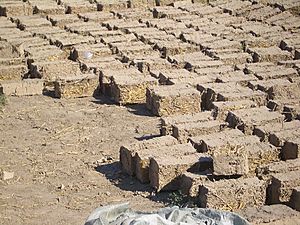
To make adobe bricks, the mud mixture is pressed into an open wooden frame. In North America, a common brick size is about 25 by 36 centimeters. After the mud is molded, the frame is removed. The bricks are then left to dry for a few hours. After that, they are turned on their side to finish drying. Drying them slowly in the shade helps prevent cracks.
The same mud mixture, but without straw, is used as mortar to hold the bricks together. It's also used as plaster for the inside and outside walls. Some cultures used lime-based plaster to protect the walls from rain.
Testing the Soil
Before making bricks, builders often test the soil. They mix a soil sample with water in a clear container. After shaking it, they let it settle for a day. The different particles (sand, silt, clay) will settle in layers. This helps them see the percentages of each. A good mix for strong bricks is 50-60% sand and 35-40% clay. The New Mexico State University suggests no more than 1/3 clay, no less than 1/2 sand, and never more than 1/3 silt.
Building Adobe Walls
The ground under an adobe building needs to be firm. Adobe walls are heavy, and if the ground settles, the walls could crack. To protect the walls, builders apply finishes like mud plaster, whitewash, or stucco. These protect the adobe from water but need to be redone regularly. Bricks made with stabilized adobe (with cement or asphalt) usually don't need these protective layers.
Adobe Roofs
Traditional adobe roofs are made from a mix of soil, clay, water, and organic materials. This mix is pressed into wooden forms to make earth bricks. These bricks are then laid across wooden beams and plastered into place with more adobe.
In dry climates without heavy snow, flat adobe roofs work well. Large wooden beams, called vigas, are placed on top of the walls. Smaller pieces of wood, called latillas, go across the vigas. Then, brush is laid on top, and finally, a layer of adobe.
Around 1850 in the American Southwest, roof design changed. Builders would put three inches of adobe mud on the latillas, then 18 inches of dry adobe dirt. The dirt was shaped to slope towards a drain, called a 'canal'. When it rained, the clay in the dirt would swell, making the roof waterproof. Once a year, people would pull weeds and reshape the dirt as needed.
Adobe roofs can also be fire-proof, depending on how they are built. Even chimneys can be made from adobe bricks, just like the walls.
Adobe Around the World
The biggest adobe structure ever built is the Arg-é Bam in Iran. It was made by the Achaemenid Empire. Other huge adobe buildings include the Huaca del Sol in Peru, which used 100 million bricks, and the ancient cities of Chan Chan and Tambo Colorado, also in Peru.
-
Still in production today, Romania's Danube Delta
-
Adobe brick house under construction in Kyrgyzstan
-
House in Sa'dah, Yemen
-
Adobe brick house under construction in Romania
-
An adobe wall in Linxia City, Gansu, China
-
Poeh Museum tower, the tallest adobe structure in New Mexico, USA
-
Great Mosque of Djenné, famous building made from banco, a type of adobe
Images for kids
-
Maintenance of historic architecture in Agadez, Niger, by adding a new layer of mud rendering.
-
Ukrainian Cossack hut
See also
 In Spanish: Adobe para niños
In Spanish: Adobe para niños


